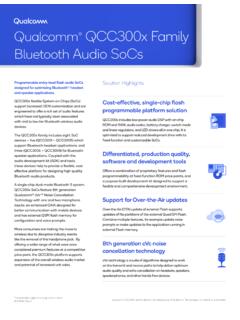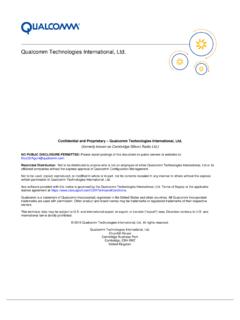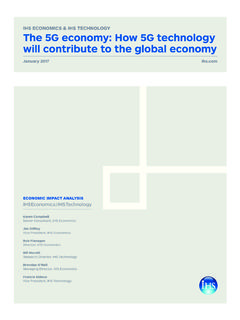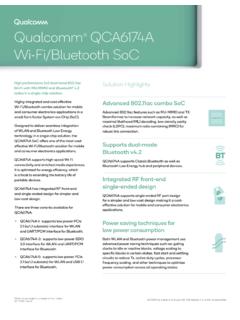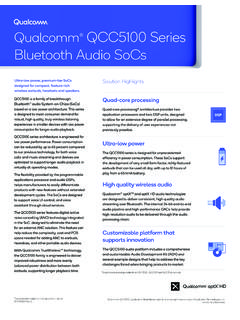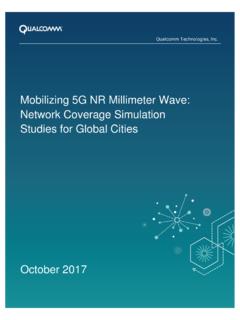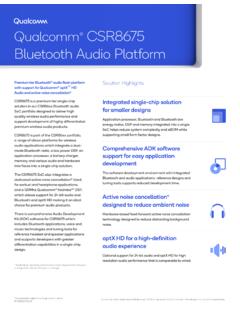Transcription of Pointer Authentication on ARMv8 - Qualcomm
1 Qualcomm Technologies, Inc. Pointer Authentication on Design and Analysis of the New Software Security Instructions Qualcomm Product Security Qualcomm Technologies, Inc. January 2017. Qualcomm Technologies, Inc. Qualcomm Snapdragon is a product of Qualcomm Technologies, Inc. Qualcomm and Snapdragon are trademarks of Qualcomm Incorporated, registered in the United States and other countries. Other products and brand names may be trademarks or registered trademarks of their respective owners. Qualcomm Technologies, Inc. 5775 Morehouse Drive San Diego, CA 92121. 2017 Qualcomm Technologies, Inc.
2 All Rights Reserved. Table of Contents Introduction .. 4. Problem 4. Pointer Authentication ..5. Instructions ..5. 6. Key Management .. 6. Sample Use Cases ..7. Software Stack Protection .. 7. Control Flow Integrity (CFI) .. 8. Binding Pointers to 9. Security Properties .. 9. Arbitrary Memory Read .. 9. Arbitrary Memory Write .. 9. Guessing and Forging PAC 9. Pointer Substitution Attacks .. 10. Key management concerns and key reuse attacks .. 10. Interpreters and Just-in-Time Compilation (JIT) .. 11. 11. References ..12. Introduction ARM recently announced , the 2016 additions to the ARMv8 -A architecture [1].
3 These additions include Pointer Authentication instructions: a mechanism for enhanced security associated with Pointer Authentication . It is very exciting to see the technology, refined and expanded through discussions and contributions from ARM and their partners, making it into the architecture as the new Pointer Authentication instructions. The Pointer Authentication scheme introduced by ARM is a software security primitive that makes it much harder for an attacker to modify protected pointers in memory without being detected. In this document, we will provide more details about the Pointer Authentication mechanism, provide a security analysis, and discuss the implementation of certain software security countermeasures, such as stack protection and control flow integrity, using the Pointer Authentication primitives.
4 Problem Definition A common problem in software security is memory corruption vulnerabilities such as buffer overflows. These vulnerabilities are often exploited by overwriting control data in memory (function pointers and return addresses). to redirect code execution to a location controlled by the attacker. There are three common ways to defend against memory corruption exploits: 1. Prevent corruption by putting sensitive data and pointers into read-only memory: This works very well for static tables of function pointers and other sensitive data. One still needs to make sure that any pointers to these read-only tables are also verified or protected.
5 Unfortunately, it does not work for dynamic pointers such as return addresses on the stack or dynamically allocated objects containing function pointers. 2. Detect corruption by verifying the pointers before using them: This is how software stack protection (SSP) works. Control Flow Integrity (CFI) and other Return Oriented Programming (ROP) mitigations such as checking various properties of the target of jumps/returns also fall into this category. 3. Make it harder to find a target: This is achieved by randomization of some form. Randomization is a good generic defense that makes it harder to reliably exploit systems.
6 Countermeasures in this category range from randomized stack/heap, which makes it harder to find a Pointer to corrupt, to full Address Space Layout Randomization (ASLR), which makes it harder to identify where to jump to. Note that some detection countermeasures like stack protection also require unpredictability ( random stack canaries). to be effective. These techniques are complementary and most modern countermeasure designs use a combination of them. Part of our product security work at Qualcomm Technologies, Inc. is introducing software security countermeasures into our platforms.
7 This covers not only the applications processor that runs the main operating system, but also images for bootloaders, peripherals such as modem, WiFi and DSP, and other execution environments like hypervisors and TrustZone. Most of these images already support three baseline countermeasures: software stack protection, Data Execution Prevention (DEP/W^X), and a hardened heap. However, these images also have size and performance constraints that make more advanced countermeasures such as ASLR and software-based CFI infeasible to implement. We wanted a scheme where we could check the validity of pointers with minimal size and performance impact, and that resists memory disclosure vulnerabilities.
8 This ruled out using XOR with a random value and other simple ways to obfuscate or scramble pointers. We needed a cryptographically strong algorithm. Using Authentication instead of encryption was an early design decision. With Authentication , the actual Pointer value is still available without having to know the secret keys. This has many advantages, from allowing branch prediction in the processor to debugging. Furthermore, with Authentication , it becomes possible to know a when corruption happened rather than just jumping to a random location and hopefully crashing.
9 The next section describes the design of Pointer Authentication . Pointer Authentication The basic idea behind Pointer Authentication is that the actual address space in 64-bit architectures is less than 64-bits. There are unused bits in Pointer values that we can use to place a Pointer Authentication Code (PAC) for this Pointer . We could insert a PAC into each Pointer we want to protect before writing it to memory, and verify its integrity before using it. An attacker who wants to modify a protected Pointer would have to find/guess the correct PAC to be able to control the program flow.
10 Not every Pointer has the same purpose in a program. We want the pointers to be valid only in a specific context. In Pointer Authentication , this is achieved in two ways: Having separate keys for major use cases and by computing the PAC over both the Pointer and a 64-bit context. The Pointer Authentication specification defines five keys: two for instruction pointers, two for data pointers and one for a separate general-purpose instruction for computing a MAC over longer sequences of data. The instruction encoding determines which key to use. The context is useful for isolating different types of pointers used with the same key.
